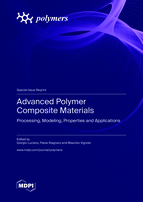Advanced Polymer Composite Materials: Processing, Modeling, Properties and Applications
A special issue of Polymers (ISSN 2073-4360). This special issue belongs to the section "Polymer Processing and Engineering".
Deadline for manuscript submissions: closed (5 October 2022) | Viewed by 72330
Special Issue Editors
Interests: polymer calorimetric characterization; spettroscopy; design of experiments
Special Issues, Collections and Topics in MDPI journals
Interests: polymer chemistry; multicomponent polymer materials; polymer processing; polymer characterization; structure–propreties relationship.
Interests: composite material processing; material characterization
Special Issues, Collections and Topics in MDPI journals
Special Issue Information
Dear Colleagues,
The subject of composite materials is truly a multi and interdisciplinary one. People who work in fields such as materials science, processing, polymer chemistry, inorganic chemistry, chemical engineering, solid mechanics and fracture mechanics, nanotechnologies, etc., are important contributors to the field of composite materials. Furthermore, polymer-based composites are often a valid alternative to traditional materials, because they combine mechanical resistance to lightness, flexibility to optical properties, formability to low cost processing. Due to their peculiar properties and versatility polymer-based composites, they have found applications in many industrial fields: construction, automotive, aerospace, biomedicine, marine, just to name a few. The performance of a polymeric composite material mainly depends on the nature of the components, the degree of interaction between its components and the processing technology.
The purpose of this Special Issue is to highlight the latest original results in the development of advanced composite materials based on synthetic/natural polymers and synthetic/natural (nano)fillers/fibers, with improved properties required by the foreseen different applications. As a consequence, the present Special Issue represents the right channel to publish on cutting-edge applications related to advanced polymeric composite materials. All kinds of polymer matrices, either commodity and engineering polymers or newly developed ones, such as bio-based and/or biodegradable polymers, from thermosets and thermoplastics to vitrimers, can be considered. The submission of manuscripts is welcome, but not limited to, those covering the following hot fields of applications:
- Energy storage and harvesting;
- Biomedicals;
- Sensors and actuators;
- Coatings;
- Textiles;
- Optoelectronics and photonics;
- Flexible and stretchable electronics;
- Membranes;
- Industrial (automotive, aerospace, naval);
- 3D printing.
Dr. Giorgio Luciano
Dr. Paola Stagnaro
Dr. Maurizio Vignolo
Guest Editors
Manuscript Submission Information
Manuscripts should be submitted online at www.mdpi.com by registering and logging in to this website. Once you are registered, click here to go to the submission form. Manuscripts can be submitted until the deadline. All submissions that pass pre-check are peer-reviewed. Accepted papers will be published continuously in the journal (as soon as accepted) and will be listed together on the special issue website. Research articles, review articles as well as short communications are invited. For planned papers, a title and short abstract (about 100 words) can be sent to the Editorial Office for announcement on this website.
Submitted manuscripts should not have been published previously, nor be under consideration for publication elsewhere (except conference proceedings papers). All manuscripts are thoroughly refereed through a single-blind peer-review process. A guide for authors and other relevant information for submission of manuscripts is available on the Instructions for Authors page. Polymers is an international peer-reviewed open access semimonthly journal published by MDPI.
Please visit the Instructions for Authors page before submitting a manuscript. The Article Processing Charge (APC) for publication in this open access journal is 2700 CHF (Swiss Francs). Submitted papers should be well formatted and use good English. Authors may use MDPI's English editing service prior to publication or during author revisions.
Keywords
- processing technologies
- modelling, simulation and material optimization
- synthetic and/or natural polymers
- modification and/or activation of polymers
- surface modifcation
- filllers and nanofillers
- (natural) fibers
- nanoparticles
- biocomposites
- bio-based hybrid materials
- renewable materials
- green chemistry
- composites and nanocomposites
- polymer composites
- biocomposites
- composite recycling
- phase compatibilization
- properties of composites
- characterization
- applications








